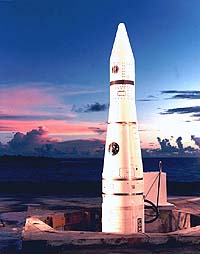| . |  |
. |
 Planned US ABM Shield Could Fail
Planned US ABM Shield Could Failby Robert Holloway United Nations (AFP) April 28, 2000 - A system of satellites and interceptor rockets which the United States wants to build against missile attack by North Korea could be thwarted by aggressors, nuclear scientists said Friday. The scientists, some of whom have worked for the US government, said counter-measures to confuse or overwhelm a missile shield were inexpensive and could be supplied by Russia or China. "We are not testing this system in anything remotely like the conditions it would encounter in an attack," Stephen Schwartz, publisher of the Bulletin of Atomic Scientists, told AFP in a telephone interview. Under a plan being studied by President Bill Clinton, the United States would deploy 100 interceptor missiles in Alaska by 2007 and an additional 150 interceptors in North Dakota by 2015. Interceptors would be guided by land-based radar and by space-based sensors. The Congressional Budget Office estimated Tuesday that the system would cost 49 billion dollars, compared with a Pentagon forecast of 26 billion. The system was designed to shoot down "a few dozen warheads" fired by a rogue state, the CBO said. It said an extra 10.9 billion dollars would be needed for 24 low-orbit infrared satellites to distinguish between warheads and decoys. Opponents of the system said decoys were only one of a range of counter-measures that might be used. Writing in the March/April issue of the Bulletin of Atomic Scientists, Richard Garwin, senior fellow at the Council on Foreign Relations in New York, compared intercepting a warhead to "hitting a bullet with a bullet." The warhead would be travelling at 10 kilometers (six miles) a second through the vaccuum of space and would be especially hard to detect if it were not spinning, he said. "Spin is added for re-entry accuracy, but the first-generation ICBMs (inter-continental ballistic missiles) of rogue states would be so inaccurate" it would make little difference if they did not spin, he said. Garwin has worked for the US government on anti-submarine warfare, sensor systems, nuclear weapons and satellite systems. He quoted a National Intelligence Estimate of September 1999, which said "Russia and China each have developed numerous counter-measures and probably are willing to sell the requisite technologies." They included shrouds of aluminium-coated plastic, which could be fitted closely over a five-foot warhead and inflated to 30 feet in diameter as the warhead re-entered the atmosphere, he said. If an interceptor hit the shroud, it would not necessarily destroy the warhead, which might have more shrouds to inflate. Kurt Gottfried, a physicist at Cornell University, said a rogue state would be more likely to attack the United States with biological weapons "delivered by bomblets" scattered from a warhead in the upper atmosphere. "The planned missile defence system could not defend against such an attack," he wrote in a report by the Union of Concerned Scientists. The report was released for the five-year review of the nuclear Non-Proliferation Treaty at the United Nations, which began on Monday. Garwin said it would be much easier to destroy an ICBM immediately after launch by homing in on its flame. "A missile under power is a thousandfold more visible than the same missile once the burn has ended," he said. "The third stage of an ICBM intercepted 10 seconds before burnout would fall about 5,000 kilometers short of its target," he wrote. A missile typically takes 250-400 seconds to reach ICBM velocity, Garwin said, and to be effective, an interceptor must reach that speed within 100 seconds. Garwin said interceptors could be fired from sea close to the attacking state and pointed out that that they were not banned by the 1972 Anti-Ballistic Missile (ABM) treaty because "they would not be effective against a single ICBM launched from the interior of Russia."
Copyright 1999 AFP. All rights reserved. The material on this page is provided by AFP and may not be published, broadcast, rewritten or redistributed.
Additional AMB Reports Today
Washington (AFP) April 26, 2000 - Russian Foreign Affairs Minister Igor Ivanov on Wednesday warned the United States away from committing the "fatal mistake" of altering a key arms control treaty between the two countries.
|
| ||||||||||
| The content herein, unless otherwise known to be public domain, are Copyright 1995-2016 - Space Media Network. All websites are published in Australia and are solely subject to Australian law and governed by Fair Use principals for news reporting and research purposes. AFP, UPI and IANS news wire stories are copyright Agence France-Presse, United Press International and Indo-Asia News Service. ESA news reports are copyright European Space Agency. All NASA sourced material is public domain. Additional copyrights may apply in whole or part to other bona fide parties. Advertising does not imply endorsement, agreement or approval of any opinions, statements or information provided by Space Media Network on any Web page published or hosted by Space Media Network. Privacy Statement All images and articles appearing on Space Media Network have been edited or digitally altered in some way. Any requests to remove copyright material will be acted upon in a timely and appropriate manner. Any attempt to extort money from Space Media Network will be ignored and reported to Australian Law Enforcement Agencies as a potential case of financial fraud involving the use of a telephonic carriage device or postal service. |